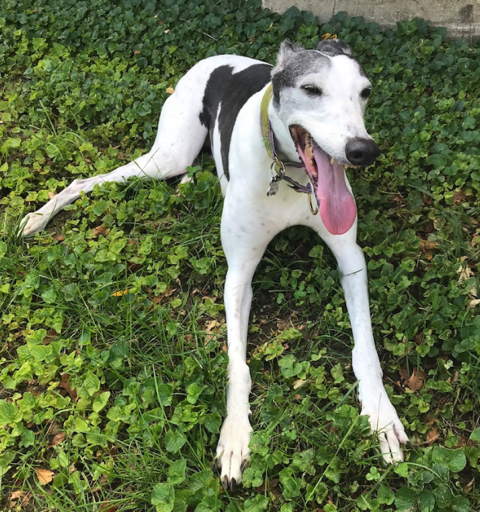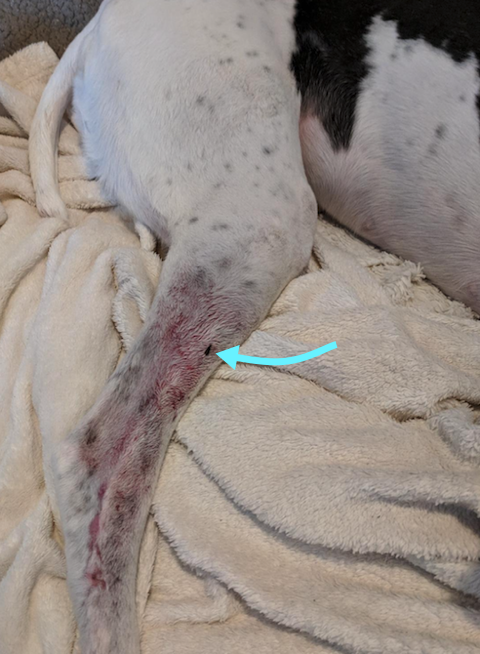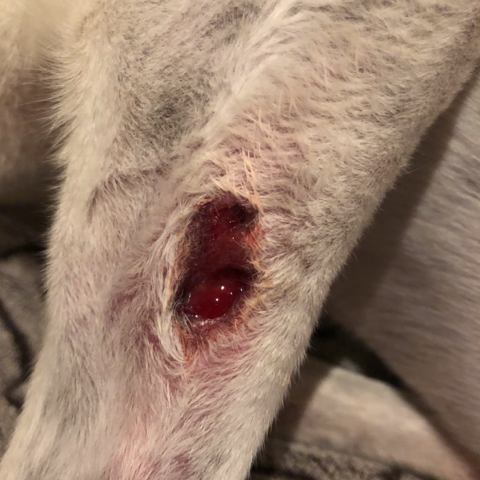(If you don’t want to see a photo of an icky wound, stop scrolling when you get to the end of the post.)
When I was in Tampa for my final trip for the bank, Leda was in boarding. Leda is my greyhound. She is nine-and-a-half years old and we have lived together since she was four. You always know the age of a retired racing greyhound because it is tattooed on the inside of their right ear.

On her second-to-last day in boarding, Leda was injured. She had two small cuts on her right hind leg, one on the inside (which she couldn’t see) and one on the outside (which she could see). That night the kennel put her in the Cone of Shame because she was licking the outside wound. Leda used the cone to abrade her leg, damaging the skin around the wound. Later that night they removed the cone to prevent further damage. When I picked her up, she had the small original wound (blue arrow) and a larger abrasion that she had caused.

Sometimes I think life conspires to ensure we learn a lesson thoroughly. I think that happened with Leda and me and her wound.
In my book, I wrote about wounds and feelings:
“ …I was choosing to walk into the grief room. I was like a six-year-old who has lost a tooth and probes the hole with her tongue, in doing so expanding the pain, and because of the nature of the innervation of the tongue, expanding the apparent size of the hole, and when continuing to probe the hole in a protracted manner, expanding the time it takes to heal. I have been that six-year-old, probing my wound, running my tongue over the edges of my grief. I have taken perverse pleasure from the pain of feeling the hole.”
It was a familiar path and I trod it recently, down in that Grand Canyon of mental habits. Leda became an in-my-face lesson about the damage that does. Leda came home and I tended to her wound. I tried bandaging it. She ate the bandages. I got her an inflatable collar that prevented only laying her head on her bed. Her wound got bigger and I sent a close-up photo (at the bottom of this post) to the kennel. I was afraid she would soon reach bone.
The vet tech saw the photo and asked, “Is she worrying her wound?” “Yes. Yes, that is exactly what she is doing.” My stomach sank as I realized that what Leda was doing physically, I was doing emotionally—we both were worrying our wounds.
The tech and I agreed that there wasn’t much to be done since Leda licks off ointment, eats bandages and damages herself with the cone. The advice was, “Do your best to keep her from licking it.” I put the phone down on the kitchen counter and looked at Leda. She looked back at me with her large brown eyes. I have never wished more that she and I could use words to talk to each other, to explain what was happening to each other.
I stood up, got a fresh dishcloth and draped it over Leda’s hind leg. The towel would be my warning sign that she was trying to lick. I watched her, at a loss for what to do. Leda looked around the room. She licked her left foreleg. Then she licked her right foreleg. Then she turned and bent her head as if to lick her right hind leg but it wasn’t there (it was hiding under the dishtowel). I could almost hear her thoughts, “I have licked all my legs and I see no more legs to lick so it must be time to sleep.” Then she put her head down and slept. Greyhounds sleep for 18 hours a day.
The key for Leda—and for me—is to clean the wound and then not lick the wound. The way to prevent licking the wound is not to see it. If I need to drape parts of my past under a clean dishtowel, that’s what I’ll do. The solution for Leda was to make jammies to provide constant coverage.

I was wrong about one thing I wrote in my book. Licking the wound doesn’t just make the apparent size of the wound bigger. It makes the actual size bigger. It takes longer to heal. It will leave a bigger scar. That’s another question—have I been wanting a scar?
That question will go unexplored because the more important thing for me is to turn my head forward. Move forward. Look where I want to go, not where I have been.
Scroll down—or don’t—to see what “worrying the wound” does to a wound.
.
.
.
.

.